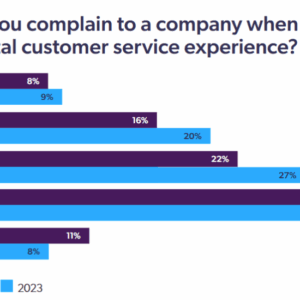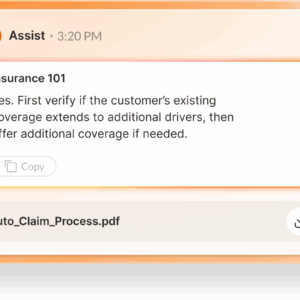



Did you know that more than half of consumers will switch to a competitor after only one bad experience? That one bad experience can be anything from using your product to interacting with your support team.
Not all customers will tell you they’re unhappy. However, those who do reach out present an opportunity for you to make things right.
How can you ensure every customer issue is addressed and resolved to the best of your team’s ability? Customer complaint tracking helps you keep customers happy and beat the competition.
Understanding customer complaints
It’s important to understand negative customer experiences and frustrations. A consumer complaint occurs whenever your business fails to deliver and meet customer expectations. You’re not eliminating pain points; you’re creating them.
The majority of customers won’t let you know they’re unhappy. For example, a report from Coveo found that 56% of respondents rarely or never complain about negative experiences.
Image sourced from conveo.com
View complaints as growth opportunities to solve issues and retain business.
What is customer complaint tracking?
Customer complaint tracking is a systematic approach to managing and resolving complaints. It ensures that every issue is logged and worked on as soon as possible. The monitoring process also helps you identify trends and gain insights.
Key elements of complaint tracking
The key elements of complaint tracking are:
- Complaint log: Records all details, such as time and channel
- Categorization: Categorizes issues by type
- Communication: Keeps the customer informed of progress via their preferred channels
- Resolution: Presents a solution to the customer
- Analysis: Helps you gain a deeper understanding of underlying product and service issues
- Take action: Drive improvement using insights
The benefits of tracking customer complaints
Tracking customer complaints requires a group effort. However, what does your business gain from monitoring customer problems?
More efficient customer service
A big part of the customer experience (CX) is the interaction between consumers and your support teams.
If your customers think you have bad customer service, complaint tracking can streamline your customer service by ensuring agents know the full context of each issue. This reduces repeat contacts and saves time, minimizing customer frustration.
Product and service innovation
Your customers are your best critics. They’ll let you know what they want from your products and services.
Tracking the data makes it easy to spot the most pressing issues and weaknesses. For instance, many customers may report product assembly issues, driving better design.
Elevated customer satisfaction and loyalty
Efficient, speedy complaint resolution means happier customers. You take a negative experience and turn it into a positive one, elevating customer satisfaction.
Loyal customers stick around longer, so you’ll see an improved customer retention rate. Equally as important, if they’re still with your brand, then they’re not spending with the competition.
Protected reputation
Compliant tracking protects your brand reputation. It demonstrates accountability to customers and aids your agents in finding a timely resolution. Nipping problems in the bud also reduces the amount of negative social proof you’ll receive from frustrated customers.
Compliance maintenance
Many compliance regulations require specific handling and documentation for handling customer data.
A complaint tracking system ensures every interaction is logged. Each action taken is recorded for compliance. For example, an audit from the Consumer Financial Protection Bureau will expect a high level of transparency.
Increased revenue
Complaint monitoring shows customers you care about them and want to solve their problems. A Qualtrics survey found that 60% of consumers would spend more money with brands that treat customers as people.
Image sourced from qualtrics.com
How to implement customer complaint tracking
You’re ready to deliver a better CX and stay ahead of the competition. So, where do you get started with overhauling customer complaint monitoring?
Set goals and standards
Every initiative or implementation starts with goals and objectives. Do you want quick initial responses to tickets or an improved quality of service?
Set SMART goals as the foundation for complaint tracking (objectives should be specific, measurable, achievable, relevant, and time-bound).
A common objective might be to raise customer satisfaction (CSAT) scores after a complaint resolution. Sure, a goal of 95% CSAT would be amazing, but is it realistic?
Also, what’s the time frame? An example goal would be “Reach 75% CSAT and resolve 75% of complaints in five working days.”
Choose a customer complaint management system
A customer complaint management system (CCMS) streamlines issue handling. A CCMS is also often referred to as a helpdesk or ticket management solution. Applications such as Zendesk make it easy for your team to process and respond to complaints.
CCMS features to look out for include:
- Ticket creation: Use multiple channels, such as email, an online portal, and a mobile app.
- Centralized ticket management: Manage inquiries and requests from one hub.
- Categorization and routing: This prioritizes complaints by urgency and routes to the appropriate agents.
- Ticket tracking: This is real-time monitoring with automated status updates that are sent to customers on their preferred channels, such as email and SMS text messages.
- Collaborative notes: Agents can work together to resolve complaints and pick up where the last person left off.
- Automated workflows: Streamline repetitive tasks, such as email updates and complaint progress.
- Reporting and analytics: Track metrics such as customer effort score (CES). Gain insight into the complaint-handling process.
Look for a solution that fits your business goals, industry, and budget. It also helps if the CCMS integrates with your existing tools for smarter workflows and new capabilities.
Use complementary tools
A helpdesk solution drives efficient and effective complaint resolution. Use complementary business tools to elevate the experience and leave the competition in the dust.
Use a customer relationship management (CRM) platform like HubSpot. During an interaction, your team sees all buyer intent data, including previous complaints. This helps them better understand and empathize with the current situation. It also speeds up problem resolution.
Another area to look at is Unified Communications as a Service (UCaaS). Solutions like RingCentral provide a central space for connecting with your team and your customers. Our omnichannel contact center empowers your agents with AI assistance and self-service options.
Image sourced from ringcentral.com
Establish processes and protocols
Every aspect of customer service needs to be consistent. Establish complaint-handling standards to guide your team and meet expectations. A good place to start is with a framework such as the ISO 10002.
Use a framework as a guide to develop your own standard operating procedures (SOPs) for areas such as:
- Customer focus: Be apologetic, gain feedback, and be committed to resolving complaints satisfactorily.
- Process improvement: Define methods for gathering and analyzing data. Promote the identification of trends to develop better products and services.
- Accountability and transparency: Take steps to keep everyone informed.
- Reviews: Regularly evaluate your complaint monitoring strategy to check for efficiency and effectiveness.
Establishing standards ensures customers get the best service and everything is documented.
Train employees
Agent training is essential for complaint handling. Educate your team with comprehensive onboarding and upskilling materials. Develop training for CCMS and your other tools, such as a cloud contact center.
You could train employees on:
- Active listening
- Empathy and emotional intelligence
- Effective, clear communication
- Complaint handling SOPs
- De-escalation techniques
- Compliance requirements
- How to record and interpret feedback
Employee education should be ongoing. Use simulations and live coaching to help agents turn weaknesses into strengths.
Monitor complaints
Use the reporting features of your complaint management tools. Live contact center reporting dashboards give your team an updated, overall view of complaint resolution. Other complaint-tracking metrics help them identify if the new system is working as intended.
Features like AI-powered sentiment analysis guide managers on when to help an agent. Such aid can raise your first contact resolution (FCR) rate. Tracking complaints also helps to reduce handling times and escalation rates.
Continuous monitoring of complaint management also informs you about where and when improvements need to be made.
Analyze data and gain insights
Monitoring every complaint results in a goldmine of customer and business data. Use analytics tools to identify patterns, such as common issues or frequent complaint sources.
For example, you may find that CES for the complaint system is higher on one channel than it is on another. Why is that, and what can you do to fix it?
Analysis may also reveal problems with your products or services. Leverage your complaint monitoring data to improve customer service and inform strategic decisions.
Communicate continuously
Effective communication is key to successful complaint management. A first response should always start with an apology, acknowledging fault and empathizing with the customer’s pain.
Be transparent at all times. Keep customers informed. Provide updates on progress and expected timelines.
Agents should be certain that a customer is happy with the proposed solution before closing the ticket. Use automated feedback surveys to glean metrics such as CSAT.
Wrapping up
Even with the best intentions, you’ll never make everyone happy all the time. Customers are unique individuals with their own needs. While a “complaint” doesn’t sound like a positive thing, your business knows better.
When someone reports an issue with a product or service, it presents opportunities. It’s an opportunity to retain a customer and build loyalty; it’s an opportunity to gather valuable information to drive improvements.
Customer complaint tracking helps your business chase perfection. By delivering exceptional service and listening to your audience, you’ll leave the competition behind.
FAQs about customer complaint tracking
How do you monitor customer complaints?
First, establish complaint-handling standards and policies. Next, you need the right tools, such as a helpdesk solution and a contact center platform.
Train your team on how to use those tools to log, manage, and resolve customer complaints. Track customer service metrics and identify ways to improve your products and the resolution process.
What tools help you track customer complaints?
Use customer complaint management systems (CCMS) to track customer issues. These are also known as ticket management solutions. A CCMS streamlines complaint handling and documentation.
Use CRM software to keep agents updated on all relevant information. AI-powered contact center apps like RingCentral RingCX empower your team with a virtual assistant. They automate workflows for speedier complaint resolutions.
Originally published May 23, 2025
Source link




No Comment! Be the first one.